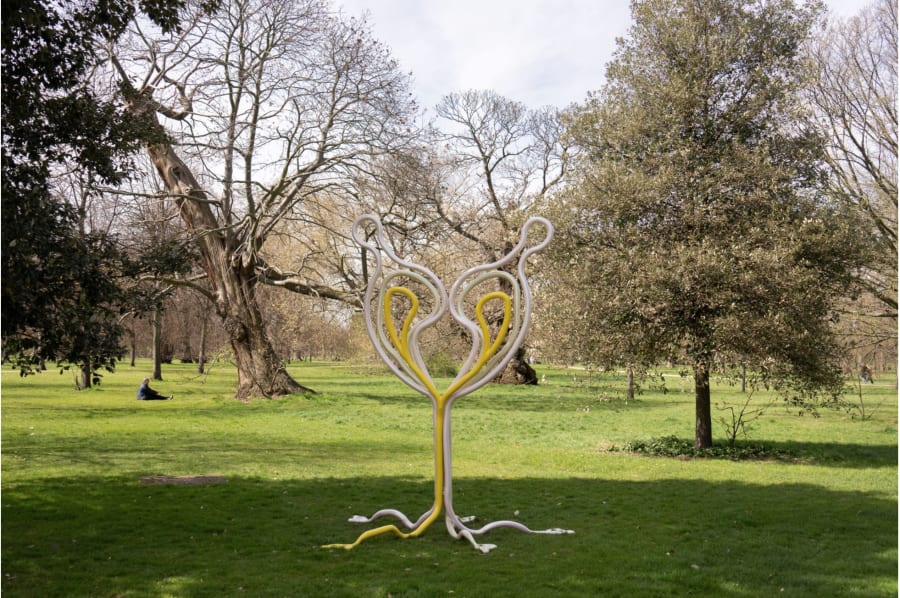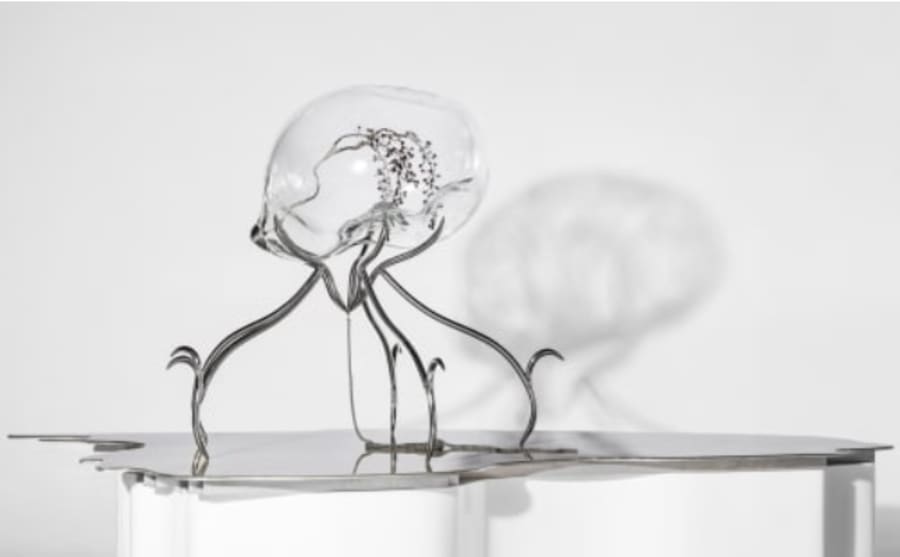‘If you make an art fair booth too much about something, it doesn’t work,’ says Marc Glimcher, the CEO of Pace. When reflecting on what he is most excited to present at this year’s Art Basel in Basel, his thoughts turn to art fairs generally: ‘There’s a real art to making an art fair booth,’ he says. ‘You’re making the booth like your living room. There has to be a beautiful dialogue between things.’
To establish this dialogue in Basel, Pace and many other galleries, including Daniel Blau, Offer Waterman, and Galería Elvira González, will present contemporary works alongside a strong selection of pieces by 20th-century masters. Galleries often spend months or even years preparing these presentations – and they are some of the most anticipated at the show.
This year, Glimcher is especially looking forward to Pace’s presentation – in collaboration with Galerie Lelong & Co and Fondation Dubuffet – of Jean Dubuffet’s Banc-Salon (1970–2024). The installation features a low, sculptural bench beneath three kites hanging from the ceiling, with each white element covered in meandering black lines rendered in Dubuffet’s characteristic, crudely elegant hand. ‘We designed the whole booth around that work,’ Glimcher says. Other 20th-century highlights at the gallery’s booth include Agnes Martin’s Untitled #20 (1974), a painting consisting of 20 horizontal bands alternating in washed-out blues and oranges that epitomizes the artist’s radical, spiritual subtlety, and Max Ernst’s Alice in 1939 (1939), a portrait of Leonora Carrington that Ernst made while he was in a French internment camp after fleeing Germany.
Isabel Mignoni, a director of Madrid-based gallery Galería Elvira González, feels a certain pride about showing Eduardo Chillida, one of the most influential Spanish artists. Born 100 years ago, he spent the second half of the 20th century developing a legacy of monumental abstract sculpture. The gallery is excited to present Deep is the Air XV (1995), a sculpture consisting of a freshly quarried chunk of alabaster with a surgically chiseled square cut from the middle – an interior room that alludes to Chillida’s architectural training. ‘This piece is very much connected with Chillida’s idea of how the void is sometimes as important to culture as the material itself,’ Mignoni says. Another work at Elvira González’s booth will be Dan Flavin’s “Monument” for V Tatlin (1970), a skyscraper-like sculpture of cool-white, fluorescent bulbs. Dedicated to the Russian Constructivist painter and architect Vladimir Tatlin, Flavin’s form speaks to Tatlin’s unrealized vision for a monumental, 400-meter-tall steel building with rotating glass rooms.
Ensuring the provenance of historical works – especially those made in turbulent times, like Ernst’s 1939 portrait – requires extreme due diligence. Besides in-house research by galleries, services like the Art Loss Register (ALR) help verify authenticity and provenance. Charlotte Chambers Farah, the global art fair manager for ALR, explains how galleries can submit artworks to the ALR, which then checks them against ‘a database of over 700,000 items that are either looted, stolen, or with reported authenticity issues,’ as well as against Interpol and other law enforcement lists. ‘When we get a match,’ Farah adds, ‘it’s often when the dealers have the work on consignment.’
Munich-based gallery Daniel Blau is showing works by artists including Georg Baselitz and Robert Rauschenberg alongside a selection of pieces from the 1980s. ‘Julian Schnabel’s 1989 painting on velvet, Untitled (Lola), is one of our highlights,’ Blau says. White gestural smears and the hand-scribbled name of Schnabel’s daughter are painted atop cranberry-colored velvet. Another Schnabel work, Untitled (Bingo) (1989), is an homage to the artist’s dog, whom he had walk in white paint and then across a piece of army-green tarpaulin, leaving paw prints behind. The gallery is also presenting Andy Warhol’s Physiological Diagram (1985), a wall-sized work that appears like an anatomical illustration, except with two clocks on the figure’s chest.
Striking pieces by British artists of the 20th-century, including Barbara Hepworth, Frank Auerbach, and Henry Moore, comprise the bulk of London gallery Offer Waterman’s presentation. Paired with these will be David Hockney’s intimate drawing Peter on the Balcony (1971). The work depicts artist Peter Schlesinger, Hockney’s lover and muse for many years, standing on the balcony of Hôtel de la Mamounia overlooking Marrakesh. It ‘captures a moment of detachment between David and Peter as they are in the final months of their relationship,’ says Stella Vasileiadou, the director of sales and client liaison for Offer Waterman.
Though all these works differ greatly in form and provenance, there is a reason why they are all being brought to the same venue. Art Basel in Basel ‘is the one place where we can meet, year after year, the most interested and dedicated clients,’ Blau says. Glimcher of Pace sums it up best: ‘This is still the far and away premier art fair,’ he says. ‘We are all going to bring our best stuff.’
Rob Goyanes is a writer and editor from Miami, Florida. His work has appeared in BOMB, e-flux journal, Frieze, Los Angeles Times, and elsewhere. He lives in Los Angeles, California.
Caption for top image: Installation view of Ottone Rosai, Nudo sul fiume, 1938 at Daniel Blau’s booth for Art Basel in Basel, 2023.
Published on June 7, 2024.


